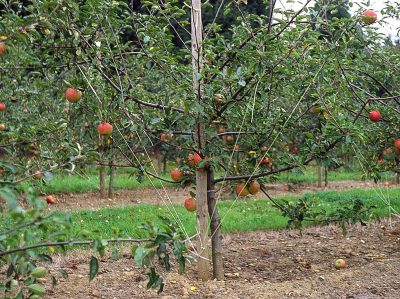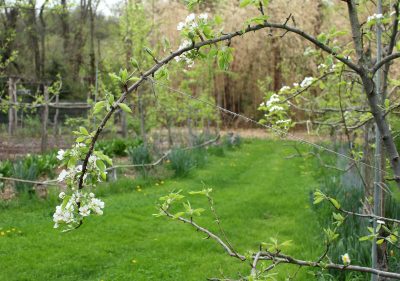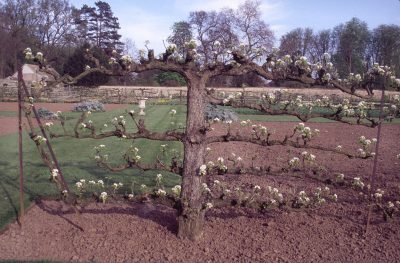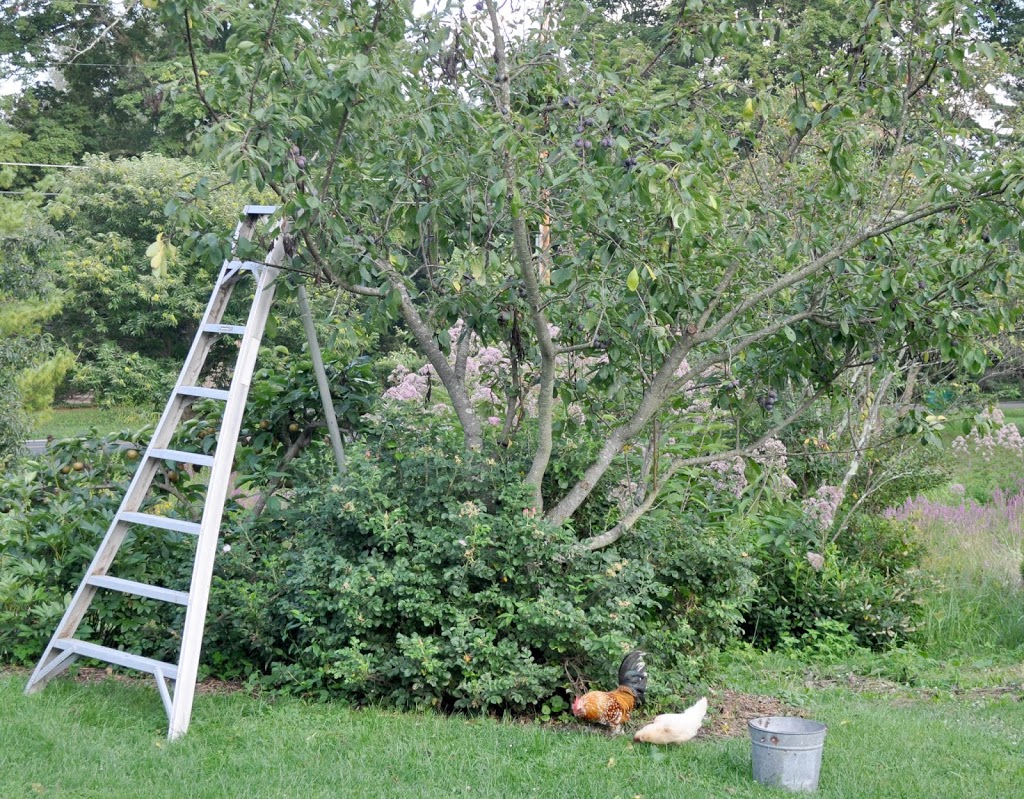Playing Around With Stems
Top Doggery
Within any plant a push and pull goes on between fruiting an stem growth. Both require energy, which the plant has to apportion between the two. The more vigorously growing a stem, the less fruitful it is.
All this talk of hormones and inherent stem vigor is more than academic; it can translate into delicious fruits.

Tied branches in British orchard
But pear trees, especially in the youth, tend to put too much of their energies, too much for me, at least, into stem growth. The result is that they can take long time to settle down and begin bearing fruit.
Hence, the strings. I can change my pear trees’ habits by merely tying down branches, reducing the effect of that auxin so that growth is more uniform along a length of the stem. And, as important, slowing growth nudges the energy balance in the direction of fruiting.

More Fruit or More Growth?
Branch bending is not only for coaxing a tree into fruiting. On young branches, it creates a wide angle between a branch and the developing trunk. Wide angles here have been shown to result in good anchorage, sturdy side branches that can carry a weight of fruit.
Suppressing the vigor of side branches also ensures that they won’t compete with the developing trunk, which needs to be top dog.
And using string to play around with plant hormones isn’t needed on every fruit tree. At the other extreme from pear in its growth and fruiting habits is peach. Peach is naturally very fecund, and becomes naturally so at a very young age.
Beauty, Fruit, and Fun
All this concern with auxin, vigor, and fruiting comes most prominently into play with espalier, which is the training of a tree to an orderly, often two dimensional form. The tracery of the branches themselves adds to the decorative value of the plant.
Fruiting espaliers, besides being decorative, produce very high quality fruit. Pruning and branch bending maintain a careful balance between yield and stem growth, and the form of the plant allows leaves and fruits to bathe in sunlight and air.




Perhaps this explains why my 5 year old pear trees have not flowered yet? They are growing rather upright, difficult to prune or get a handle on…I have a Tyson, Golden SPice and a Hudak from St Lawrence.
Can I do this on a Chamaecyparis obtusa ‘Splitrock’ that I want to fill out horizontally and not vertically in front of some very low windows. I weighted down the one long branch during the winter, which was the main branch, but it is gradually rising again. And I wasn’t aware that it should be in a downward arc. Can I just keep tying various branches to keep it in a shape I want without damaging it long-term? It’s a beautiful plant, just too tall. I’m assuming I shouldn’t prune back the main branch.
I think yes, probably. A downward arc will promote vigorous shoots from the high point of the arc. What you probably want is non vigorous growth along the bent stem, in which case keeping the stem horizontal rather than arched would be better. Or at a slight upward angle if you want faster growth of the bent branch.
I have a pear tree that is very very tall (about as tall as a 2-story house).Two years ago it had many fruits but to high to harvest. This year there’s no fruit at all. I am considering the option of cutting it down. What would you recommend I do?
Don’t cut it down if the pears taste good. Lower the tree over a number of years by making one or two large cuts low in the tree and then selecting new stems from those that sprout near the cut for the future framework of the tree. (More about this, of course, in my book THE PRUNING BOOK.) And then prune it annually and bend branches to keep it from getting to tall again.
I have a young pear tree, 3 years old and there are two trunks the same diameter growing from the ground. Should I remove one or let it grow. The tree looks healthy.
I would.